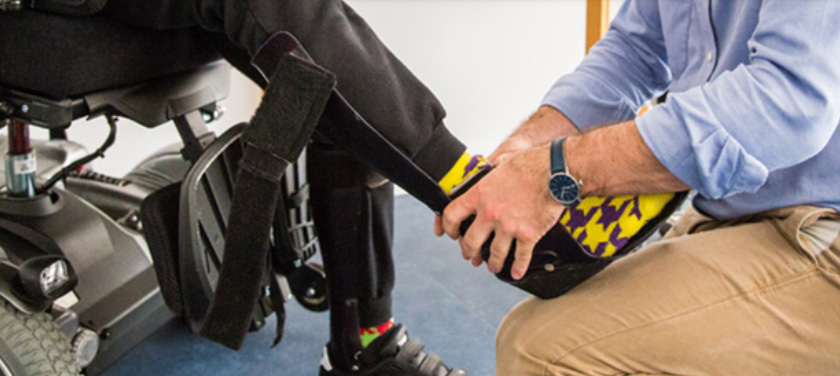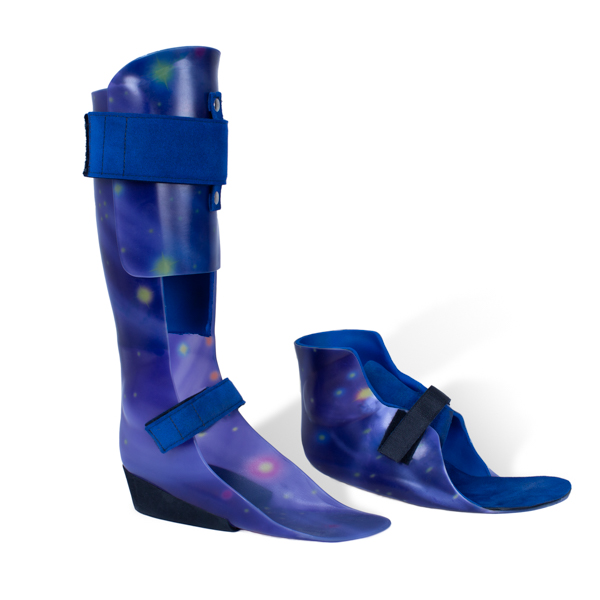Spina bifida is a birth defect of the neural tube. The neural tube eventually develops to form the spine and nervous system. If it doesn’t form correctly, damage to the spinal cord can occur, causing neurological dysfunctions, such as lower-limb paralysis, sensory impairment and incontinence.
The cause is unknown, however, lack of folic acid during early pregnancy can increase the risk of this birth defect occurring.

There are three different types of Spina Bifida: occulta, meningocele and myelomeningocele. Symptoms vary according to the type. In spina bifida occulta, there are rarely long-term health problems. Myelomeningocele is the most severe type and results in lower limb paralysis, sensory impairment and incontinence - Hydrocephalus is also common with these babies.
Spina bifida is usually diagnosed prenatally during standard ultrasounds and blood tests that are carried out in pregnancy. To confirm the diagnosis, an MRI or CT scan may be carried out within three months of birth.
Again, treatment depends on the severity of the condition. With the more severe types, surgery is now indicated in infancy to protect the exposed spine and central nervous system. If detected early on in pregnancy, surgery can be carried out in the second trimester.
If lower limb paralysis is present, this is managed with physiotherapy to maintain good range at the hips, knee and ankle. Lower limb orthotics are used to provide stability and aid mobility.
Typically in spina bifida, orthotic intervention would be either ankle foot orthoses (AFOs) or knee ankle foot orthoses (KAFOs).
Initially, AFOs are used in young children to prevent contractures and provide stability to help children learn to stand. When children are learning to walk, fixed AFOs or ground reaction AFOs (GRAFOs) can be used to provide sufficient force for push-off in the stance phase and stabilise the knee joints.
As children grow and become more mobile, they may require additional control at the hip and knee and a KAFO may be indicated with locked knees to facilitate mobility.
Although permanent, this condition requires continued reassessment as each child grows, to ensure their orthotic prescription is optimal for their needs. At LOC, we work closely with the neuro team, such as physios, occupational therapists and parents to complement the therapy that they are receiving with advanced orthotic treatment for each child. As they grow so do the complexities of their gait with increased height and weight. The orthotist will adjust and redesign your orthotic prescription using our Gait Lab facility to optimise effectiveness.
Shine is a charity that provides advice, help and practical support for those affected by spina bifida and hydrocephalus.
Formerly known as the Association for Spina Bifida and Hydrocephalus (ASBAH), the charity supports families across England, Wales and Northern Ireland.

An AFO is an Ankle Foot Orthosis which as the name would suggest encompasses the ankle and foot. The objective is to control the position and movement of the ankle. AFOs are used to support weak limbs; they can also be used to immobilise the ankle and lower leg to correct foot drop. When set up correctly they can also have a great influence on the knee and hip joints. They are the most commonly used Orthoses.
The length of time that one needs to wear an AFO very much depends on the condition being treated. If it is a long-term condition like cerebral palsy or post-polio syndrome it is likely to be years as the condition cannot be cured. Your orthotist will advise you.
A patient’s comfort in their AFO is vital for compliance with the prescribed wearing regime.
So there are a number of steps the orthotist should take to ensure a comfortable fit: the patient’s heel should fit fully into the heel cup without excess space, the contours of the plantar surface of the AFO should match the patient’s foot, for children there needs to be up to half an inch growth room in the toe shelf length. At LOC we use our Gait Laboratories at our Kingston and Manchester clinics to fine-tune our bespoke orthotics.
A GRAFO is used to control instabilities in the lower limb by maintaining proper alignment of limbs and controlling their motion. It reaches around to the front of the knee extending down to the ankle. It works by altering a patient’s limb presentation to displace load and impact as well as offering further control to the knee.
The cost of an AFO is dependent on the type of AFO that has been prescribed and the material that it has been made with. Carbon fibre will be more expensive than metal or plastic for example. LOC’s bespoke AFOs cost can be found on our Orthotic Prices page.
The ability to drive while wearing an AFO is dependent on the condition being treated and the orthosis that has been prescribed. If wearing a hinged AFO, for example, you will be able to drive, but if wearing a knee brace, you won’t. Your orthotist will advise you.
The most flexible type of AFO is a Dynamic Ankle Foot Orthosis (DAFO). It is thin and provides flexible support to the foot and ankle.
Both normal AFOs and DAFOs improve static balance (eg: while standing). Research among MS sufferers suggests that DAFOs aided balance while walking more than AFOs.
The simple answer is: yes they can. However one has to be sensible and look for wide-fitting trousers/jeans preferably of light and thin material.
Typically an AFO is stiff and rigid whereas a DAFO is thin, flexible and wraps around the patient’s entire foot. A DAFO provides support but also allows some range of normal movement.
A Supra Malleolar Orthosis SMO gets its name from the part of the body it encompasses. Thus an SMO supports the leg just above the ankle bone or malleoli. It allows dorsiflexion and plantar flexion(toes up and toes down) but eliminates mediolateral movement.
It typically takes a few weeks but is slightly dependent on the chosen materials and current availability.

Sofia’s AFOs Help Her to Stand and Walk During Lockdown

LOC’s gait lab has helped Lilac to move independently

Sam Walmsley to explain OSKAR Framework to Neuro Conference 2021 Delegates

Meet John Turner – our Manchester Orthotics Lead

LOC to launch OSKAR Framework to CMSUK 2020 Delegates

OSKAR Clinic AFOs and gait laboratory are game-changers for cerebral palsy patient Austin

Cerebral palsy patient, Sophie, maintains independence during lockdown with LOC’s help